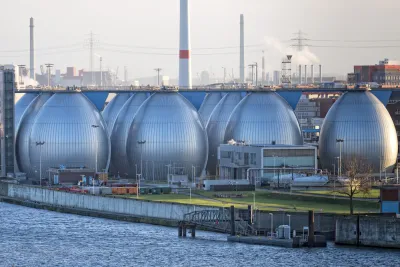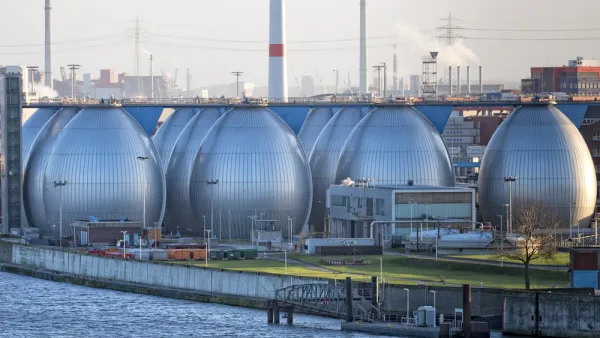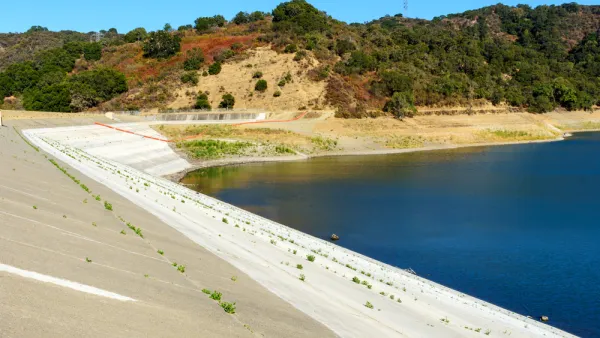Less than a decade ago, "desal" proposals in California numbered over 22, but only one major one was built—in Carlsbad, serving the San Diego region. A newly released study by the Pacific Institute explains why.

“There are some people who still hold onto [desalination] as the Holy Grail,” says Heather Cooley, Director of the Pacific Institute’s Water Program, “that thing you’re seeking that’s going to solve our [drought problem in California].” Cooley is also the co-author of a new study on the costs of various strategies to augment drinking water supplies. But more on that later.
Since those first 22 desal plants have been proposed, "plans have been scrapped in Marin, Santa Cruz and other coastal cities," reports David Gorn for KQED Science (audio also available). "A tiny desal plant has been constructed in Sand City, north of Monterey, but only one significant project has been completed."
Poseidon Water
That would be what is now the nation's largest desal plant, the $1 billion Claude "Bud" Lewis Carlsbad Desalination Plant located 30 miles north of San Diego, adjacent to the Encina Power Station in Carlsbad, California, although when it was approved in 2008 the cost was $300 million.
"A 30-year Water Purchase Agreement is in place between the San Diego County Water Authority and Poseidon Water for the entire output of the plan," according to the Boston-based private company that built the plant which began operation in December 2015.
San Diego's location "at the end of a very long plumbing system, 500 miles from its nearest source," helps explain why the water authority engaged in the contract with Poseidon, explains Peter MacLaggan, a senior vice president with Poseidon.
The company's second plant, the Huntington Beach Desalination Plant currently under development, may prove whether the Carlsbad plant was the start of a movement toward large desal or more of a 'one-of-a-kind' project.
There are two major drawbacks to building desalination plants: damage to the marine environment as well as other environmental impacts, such as the carbon emissions resulting from the burning of fossil-fuels to power the plant, and the financial costs.
Environmental impacts
Ray Hiemstra of Orange County Coastkeeper, a South Coast environmental watchdog, is quick to point to the former on the Huntington Beach proposed plant:
One of the big problems with taking salt out of seawater, says Hiemstra, is what to do with the salt after it’s removed; that highly concentrated brine typically goes back into the ocean. At Huntington Beach, you can see the outflow pipe just a thousand feet offshore.
"The Carlsbad plant isn’t even a year old but state officials have cited it a dozen times for environmental violations," adds Gorn.
That includes what they call “chronic toxicity,” from an unknown chemical used in water treatment that has been piped into the ocean. The company is still trying to identify, isolate and clean it up.
Financial costs
On Oct. 13, the Pacific Institute, a "global water think tank" based in Oakland, Calif., released "The Cost of Alternative Water Supply and Efficiency Options in California." The group calls the report "the first comprehensive analysis to examine the cost of various strategies throughout the state to augment local water supplies and reduce water demand in urban areas.
Cooley tells Gorn that "the expense is the main reason communities have turned away from desalination."
“As many of these projects sort of went through the process and started looking more seriously at the cost,” she says. “There started to be concern that that was too high, that there very likely were other options.”
Her study [excerpted below] details the costs of the different strategies to both increase water supply and decrease demand.
The study finds that the cost of new supplies in California is highly varied. Large stormwater capture projects are among the least expensive of the water supplies examined, with a median cost of about $590 per acre-foot. By contrast, seawater desalination, with a median cost of $2,100 per acre-foot for large projects and $2,800 per acre-foot for smaller projects, is among the most expensive water supply options.
Generally, the cost of recycled water is in between that of stormwater capture and seawater desalination. [Also see tags for Recycled Potable Water and Recycled Wastewater].
One type of desalination plant that may prove relatively cost-effective is inland brackish water desalination as opposed to coastal desalination.
Returning to the aforementioned Huntington Beach Desalination Plant proposal, the company indicates that it is in "the final phase of the project’s permitting process.....and is scheduled to be operational by 2019."
Related:
- Pacific Institute: The Cost of Alternative Water Supply and Efficiency Options in California, October 13, 2016
- Los Angeles Times: Desalination plants aren't a good solution for California drought, April 24, 2015
Also on Planetizen:
-
California Studies Standards for Recycled Drinking Water, July 27, 2016
-
Management, Not Technology, Will Solve California's Drought, April 9, 2015
-
California Turns Toward the Sea for Drought Relief, March 4, 2015
-
Desalination Plant Approved in California, August 11, 2008
FULL STORY: Desalination: Why Tapping Seawater Has Slowed to a Trickle in California

Analysis: Cybertruck Fatality Rate Far Exceeds That of Ford Pinto
The Tesla Cybertruck was recalled seven times last year.

National Parks Layoffs Will Cause Communities to Lose Billions
Thousands of essential park workers were laid off this week, just before the busy spring break season.

Retro-silient?: America’s First “Eco-burb,” The Woodlands Turns 50
A master-planned community north of Houston offers lessons on green infrastructure and resilient design, but falls short of its founder’s lofty affordability and walkability goals.

Test News Post 1
This is a summary

Analysis: Cybertruck Fatality Rate Far Exceeds That of Ford Pinto
The Tesla Cybertruck was recalled seven times last year.

Test News Headline 46
Test for the image on the front page.
Urban Design for Planners 1: Software Tools
This six-course series explores essential urban design concepts using open source software and equips planners with the tools they need to participate fully in the urban design process.
Planning for Universal Design
Learn the tools for implementing Universal Design in planning regulations.
EMC Planning Group, Inc.
Planetizen
Planetizen
Mpact (formerly Rail~Volution)
Great Falls Development Authority, Inc.
HUDs Office of Policy Development and Research
NYU Wagner Graduate School of Public Service



























